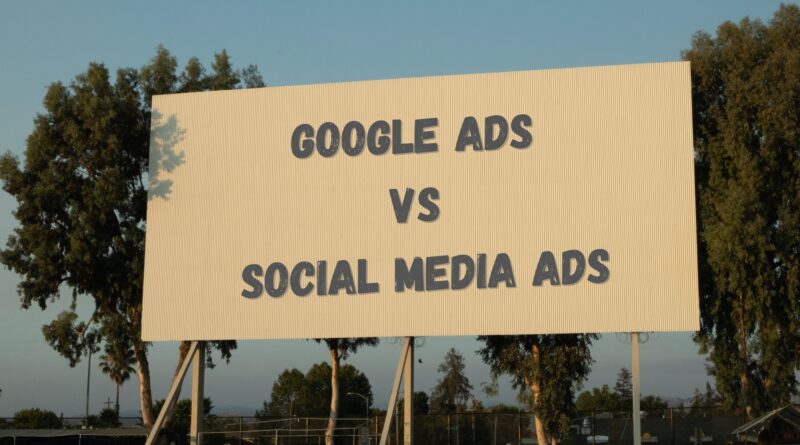Google Ads vs Social Media Ads: Which One is Better For Your Brand?
Advertising on digital media
Ever since the advent of the internet, digital marketing has slowly crept in and today stands as one of the most sought-after marketing verticals.
With customers spending most of their time browsing the internet, brands and businesses have begun focussing on internet marketing to reach their audience quicker and more effectively.
This concept of marketing over the internet is digital marketing. Today, digital advertising has become more popular than ever, with paid ads taking centre stage when it comes to digital advertising.
Digital advertising is the process of marketing products and services by running paid promotional campaigns across digital mediums.
It includes promoting on platforms like social media, web browsers, blogs, applications, and any other platform that involves the internet.
Today, there are agencies that help you achieve your digital marketing and advertising goals. Consider hiring the services of a digital marketing agency in India as they will help grow your business by multi-folds!
When it comes to paid advertising in digital marketing, there are two major streams – Google and social media ads.
While both have been pitted against each other for a long time now, digital marketers have started using a combination of both these digital advertising platforms to their advantage.
Well, you know what they say about a TEAM – Together Everyone Achieves More – Google and social media ads together make a great team!
However, as individual mediums, they have their own strong suits. This blog will discuss this and also try to answer the unending question – which channel is better for your brand – social media ads or Google ads? Read on to find out!
Defining Google ads and social media ads
Google ads and social media ads are two of the most popular mediums (or players) when it comes to paid advertising on digital marketing platforms.
So, if you are looking to run ad campaigns on digital, you cannot skip these mediums. You have to understand how they work and how beneficial they are before choosing between them.
Let us understand the concepts of advertising on social media and Google and the benefit that each comes bearing before we conclude.
Social media ads
Social media advertising is basically running paid ads across social media platforms, including Facebook, Instagram, WhatsApp, LinkedIn, Twitter, and more.
Simply put, most of the platforms that fall under Facebook (now Meta) are considered social media advertising platforms.
It has been proven that social media ads are of immense help in branding and growing your social media community.
They help increase awareness and engage with your audience, who are also potential customers. Let’s discuss a few benefits of running social media ads before moving on to Google ads!
Benefits of running social media ads
1. Excellent branding opportunity: Social media advertising is a great branding opportunity. Social media platforms, in general, help spread awareness about your brand amongst users and your audience.
Increasing brand awareness must happen when users are not ready to buy your products or avail your services.
2. Streamlined targeting: Most social media platforms allow you to narrow down on your target audience based on a handful of important factors, including location, age, gender, interests, browsing habits, and more.
This also helps in learning more about your audience, what works and doesn’t work with them.
Running social media ads provides us with insights into our audience, their activities, and preferences, which in turn helps in tweaking and optimising our campaigns and strategies.
3. Increased engagement: Social media platforms are known for allowing users to interact with fellow users and brands.
With social media ads, you can reach a wider audience, and this, in turn, will increase your chances of engaging with them.
Targeting the right audience will help attract them to engage with your content, thereby pushing them to the next stage of the funnel.
4. Higher inbound traffic: Social media helps reach potential customers outside of your funnel. Most of your conversions and sales will be only through existing customers without social media ads.
With social media ads giving an increased reach, your inbound traffic will also naturally grow.
Advertising on social media opens up your business to a broader and more diverse set of audiences and customers.
5. Improved brand loyalty and authority: Today, most customers of all age groups are present on social media.
Running social media campaigns will help keep your potential customers informed about your brand, thereby increasing brand awareness.
Over time, with collective marketing efforts along with a solid social media ads strategy, you would have grown a loyal customer base and would have garnered brand loyalty and gained brand authority as well.
Google ads
While social media ads are used mainly at the awareness stage of marketing or the ads funnel, Google ads come in handy when the brand needs actual conversions.
The most popular way to gain more high-quality leads is using Google ads. Most businesses that want to massively improve their lead generation usually resort to Google ads.
Google ads offer advertisers different formats of ads for them to run, including search ads, video ads, display ads, and application (app) ads.
Search ads appear exclusively on the Search Engine Result Page (SERP), while app ads can appear anywhere on Google, within its network and also within other ad-engaging apps.
Google ads help advertisers target websites of the audience’s interests and post relevant ad content for them to engage with. On a side note, when you run ads on YouTube, it falls under Google ads!
Let’s discuss the advantages of Google ads in the coming section!
Benefits of running Google ads
1. Excellent targeting: Google is constantly looking to improve its algorithm. With that being established, Google as a platform itself has a massive reach, making it easier for businesses to target right.
There are many ways to target your audience via Google ads, including bidding for long-tail keywords and broad keyword search terms.
Google ads also allow for relentless targeting and retargeting. Buyers with high intent to buy are the ones who are more likely to convert.
Google ads allow you to reach them using the long-tail keyword bidding approach.
2. Quick way to generate leads: It is easier to generate leads via Google ads than build an SEO strategy to gain leads organically.
With excellent targeting options, Google ads don’t take time to bring high-quality and most likely-to-convert leads to the table.
It is an established fact that paid traffic makes for more conversions than organic traffic. With Google ads, you can target bigger and better, thereby subsequently increasing your inbound traffic.
Read: Lead Generation Methods
3. Leveraging intent of the audience: Intent is of the highest significance when it comes to Google ads.
Google is smart enough to track down users’ intent and show them content that aligns with their interests.
Google ads allow you to target those sets of audiences that are looking for products or services you are offering.
With this unmatchable feature, you will be promoting your products or services to people who want to be advertised to.
4. Control over budget spends: With traditional methods of advertising, it is almost always challenging to keep the budget under control.
Google eliminates this issue as it allows the campaign manager to bid for select keywords, assign the number of bids you want to make, and even set daily budgetary limits.
This way, you will always be able to keep constant tabs on your campaign’s or ad spends.
5. Excellent ROI: Google ads is known for its excellent return on investment. You might have heard the famous saying on Google ads – “spend money in order to save money”.
There are three ways in which you can maximise your returns.
a. Cost Per Click (CPC) – You will only be paying for every click on your ad.
b. Cost Per Action (CPA) – You will pay for every critical action that a user makes on your ad.
c. Cost Per Thousand Impressions – Also known as Cost Per Mille (CPM), it is the price an advertiser will pay upon reaching the thousandth view on his ad.
Now that we have discussed the pros of both social media ads as well as Google ads, let us move on to see which of these ad platforms is better for your brand.
In conclusion – Google ads or social media ads?
As discussed earlier, social media ads and Google ads are two of the most major players in the digital marketing ads field.
For a long time now, Google ads and social media ads have been pitted against each other and seen as competitors. But as we saw, both serve slightly different but equally important purposes.
> Social media ads, on the one hand, take care of branding, creating brand awareness, loyalty, and authority for the brand. This is basically the primary goal for a brand when we look at the larger picture.
> Google ads, on the other hand, focus on the sales aspect more than branding. It aims to hard sell in order to garner solid, high-quality leads and conversions.
Therefore, when used in concert, paid search (Google ads) and paid social (social media ads) can produce great results for the brand, helping it grow multi-fold.
With increased brand awareness, loyalty, and authority, and improved quality of leads and solid conversions, a brand is only set to experience growth like never before.
The next time you find yourself at crossroads with regard to google and social media ads, remember, both these ad mediums complement each other! So, use them both to your advantage!




